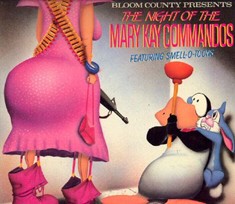 It should go without saying that we do our best to keep apprised of the goings-on in North-East India, a place near-and-dear to our hearts. (Yeah, we have multiple hearts—what of it?) We were thus chilled to learn recently that the esteemed province of Nagaland has been invaded by Mary Kay Cosmetics. And the grand-dame of multi-level marketing enterprises is taking no prisoners in its attempt to turn India’s tribal citizens onto the supposed wonders of the MelaCEP Whitening System:
It should go without saying that we do our best to keep apprised of the goings-on in North-East India, a place near-and-dear to our hearts. (Yeah, we have multiple hearts—what of it?) We were thus chilled to learn recently that the esteemed province of Nagaland has been invaded by Mary Kay Cosmetics. And the grand-dame of multi-level marketing enterprises is taking no prisoners in its attempt to turn India’s tribal citizens onto the supposed wonders of the MelaCEP Whitening System:
“There are around 800 to 900 sales force members in Nagaland alone” stated Puneet Madan, Director of Sales Development. He said that it was not only Dimapur that was showing a positive response. Other districts of Nagaland as well such as Peren, Phek and Mokokchung were showing a tremendous interest in Mary Kay products, he said. Dave Grant, Vice President of Sales Development and education of Mary Kay Asia Pacific Region and other Mary Kay representatives were also present at the press conference.
If we assume a Nagaland sales force at the midpoint of Madan’s estimate, that means the province has one Mary Kay rep for every 2,352 citizens. In the U.S., by contrast, the figure is one for every 3,529 men, women, and children.
Suffice to say, we don’t think Mary Kay’s arrival should necessarily be hailed as a great advancement for the North-East. Quite the contrary, in fact—we consider ourselves great skeptics of the Mary Kay model, which seems far more concerned with making coin off starry-eyed “consultants” than actually moving product to customers. And if these figures are accurate, that certainly seems to be the case in India.
Plenty more on the Mark Kay business model here—we highly recommend the section that breaks down the math on those “free” cars.


scottstev // Feb 1, 2010 at 11:54 am
Yeah, you learn early on, that in multi-level marketing, you’re basically recruiting your own competition. Instead of getting an exclusive area for a franchise, you are asked to bug every one of your friends and neighbors to buy the business. Imagine you walk into -say a cosmetics store. Then imagine instead of actually selling you cosmetics the owners kept pestering you to open up another store in the shopping center down the street.
PS – Much props for the “Bloom County” name-check. That strip taught me more about the early eighties than all my social studies classes.
Brendan I. Koerner // Feb 1, 2010 at 1:47 pm
Hear you on the “Bloom County.” Opus taught me everything I ever needed to know about the Iran-Contra Affair.
It’s the whole pink Cadillac scam that really makes me dislike Mary Kay. Sorta reminds me how shady ’50s record producers would mollify their underpaid acts with cars, while stiffing them for fortunes’ worth of royalties. It’s just a way to take the mark’s eyes off the true nature of the business.
Jordan // Feb 1, 2010 at 1:51 pm
“Even their uzis are pink!”
Yeah, my knowledge of the 80s is shaped in large degree by Bloom County, Doonesbury, and the political cartoons of David Horsey. Not exactly unbiased sources. But oh how funny they were.
Did you catch the post on Coates’ blog about skin whitening creams in South Asia? Some of the comments were pretty enlightening.
http://ta-nehisicoates.theatlantic.com/archives/2010/01/color_struck.php
AP Keshari // Feb 3, 2010 at 5:48 am
Indeed, MaryKay is not the first or only invader. The Indian state of Nagaland has been reeling from the impact of the Baptist Church’s invasion that began some years ago and refuses to abate.
These missionaries and their cohorts have turned the indigenous way of life upside down, begun interfering in the secular democratic process, and alleged even to be funding barbaric and secessionist rebel groups.
America’s rightwing loonies & their pernicious exports are having an effect in places they couldn’t even have imagined!
Brendan I. Koerner // Feb 3, 2010 at 8:14 am
@AP Keshari: Excellent point, thanks for raising it. I touch on the influence of American Baptist missionaries on Naga society/politics in my book. I also have very vivid memories of being invited into a tribal home in the Patkais, where I was served tea beneath a six-foot-tall Jesus-and-the-lamb tapestry. That created a fair bit of cognitive dissonance.
I’d be interested to know about what percentage of the NSCN’s funding comes from American religious groups. I bet it’s an enormous share.